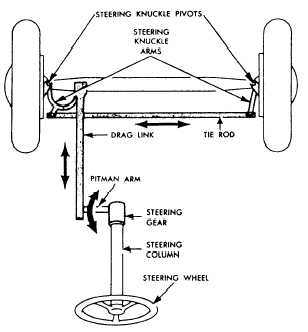CHAPTER 3
CHASSIS SYSTEMS
Chassis systems provides operators with a means of
controlling the direction the equipment travels and
allows travel over uneven terrain by controlling the
amount of shock reaching the passengers or cargo. This
chapter covers the basic principles of steering systems,
suspension systems, tires, and brake systems.
STEERING SYSTEMS
Automotive steering mechanisms are classified as
either manual or power. In both types, the arrangement
and function of the linkage are similar. The main
difference is that manual steering requires more effort
for you to steer the vehicle. Some construction
equipment has articulated steering which is powered by
the equipment hydraulic system.
STEERING MECHANISMS
All steering mechanisms have the same basic parts
(fig. 3-1). The steering linkage ties the front wheels
together and connects them to the steering gear case at
Figure 3-1.—Steering linkage assembly.
the lower end of the steering column which, in turn,
connects the gear case to the steering wheel.
The arms and rods of the steering linkage have ball
ends or ball-and-socket ends to provide a swivel
connection between them. These joined ends have
grease fittings, dust seals or boots, and many of them
have end-play adjustment devices. These joints and
devices must be adjusted and lubricated regularly.
The arms, rods, and joints of steering linkage in your
equipment may be arranged differently from those
shown in figure 3-1, but you will find them in the same
general location in the front and underneath the vehicle.
The tie rod is usually behind the axle and keeps the
front wheels in proper alignment. The tie rod is divided
into two lengths and is connected to the steering gear
near the center of the vehicle to provide for easier
steering and maximum leverage.
The drag link between the steering arm and the
pitman arm may be long or short, depending on the
installation.
The pitman arm is splined to the shaft extending
from the steering gear case. It moves in an arc with its
position, depending on which direction the steering
wheel is turned. The arm is vertical when the front
wheels are straight ahead. Therefore, the length of the
drag link is determined by the distance between the
steering arm and the vertical position of the pitman arm.
Unlike the tie rods, the length of the drag link is fixed.
Part of your prestart and operator maintenance
responsibilities is to check and service the steering
linkage lubrication. One example is the connecting
joints between the links that contain bushings.
Additionally, when a vehicle is equipped with manually
operated steering, check the steering gear housing for
lubrication, and, if needed, add the recommended
manufacturer’s gear lubricant. If the vehicle is equipped
with power steering, check the belt tension because
improper tension can cause low oil pressure and hard
steering. Check the fluid level. If the fluid level is low,
add fluid to bring it up to the recommended level and
only use the recommended power steering fluid. Also,
if the level is low, there may be a leak; therefore, check
hose and power steering connections for signs of leaks.
3-1

